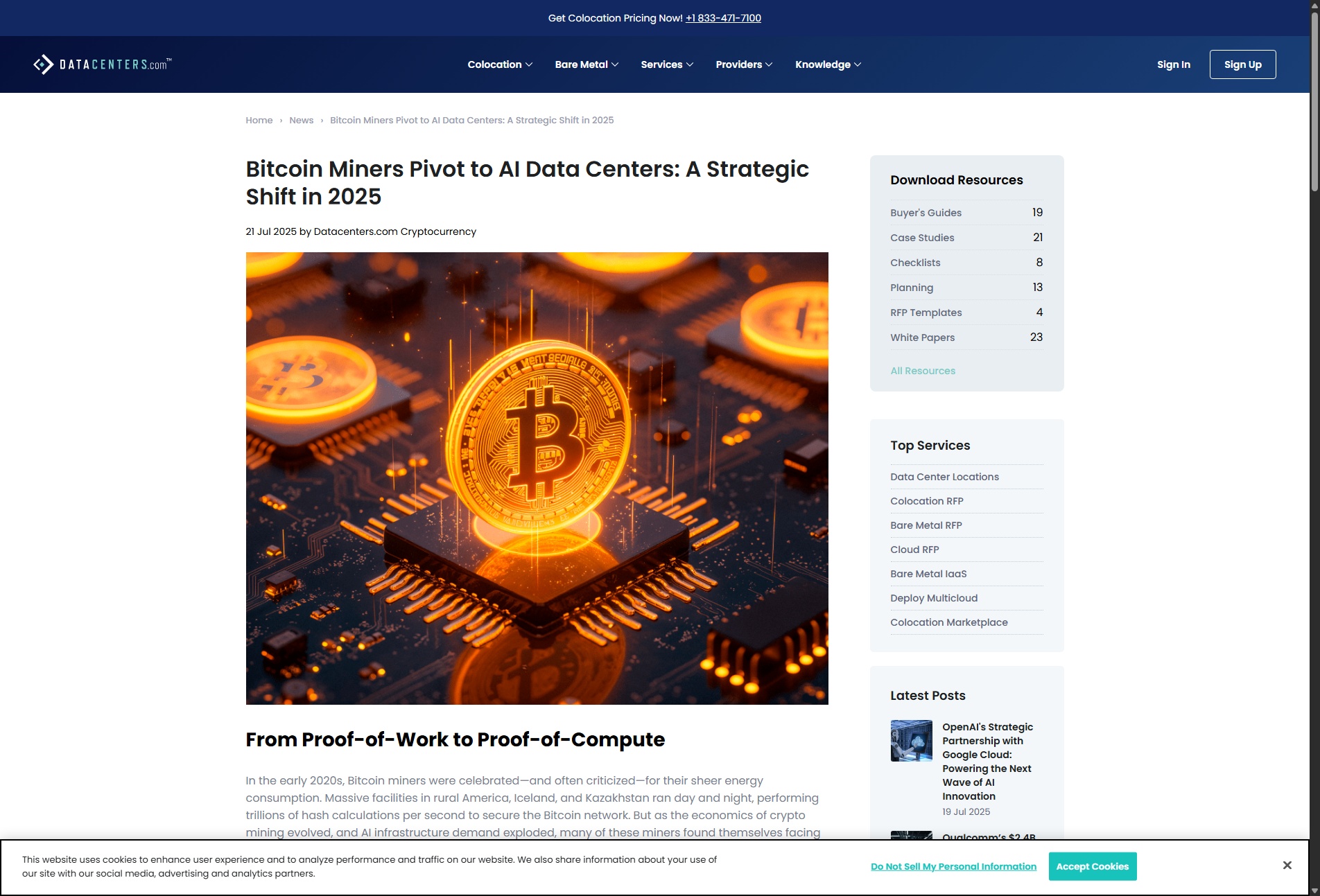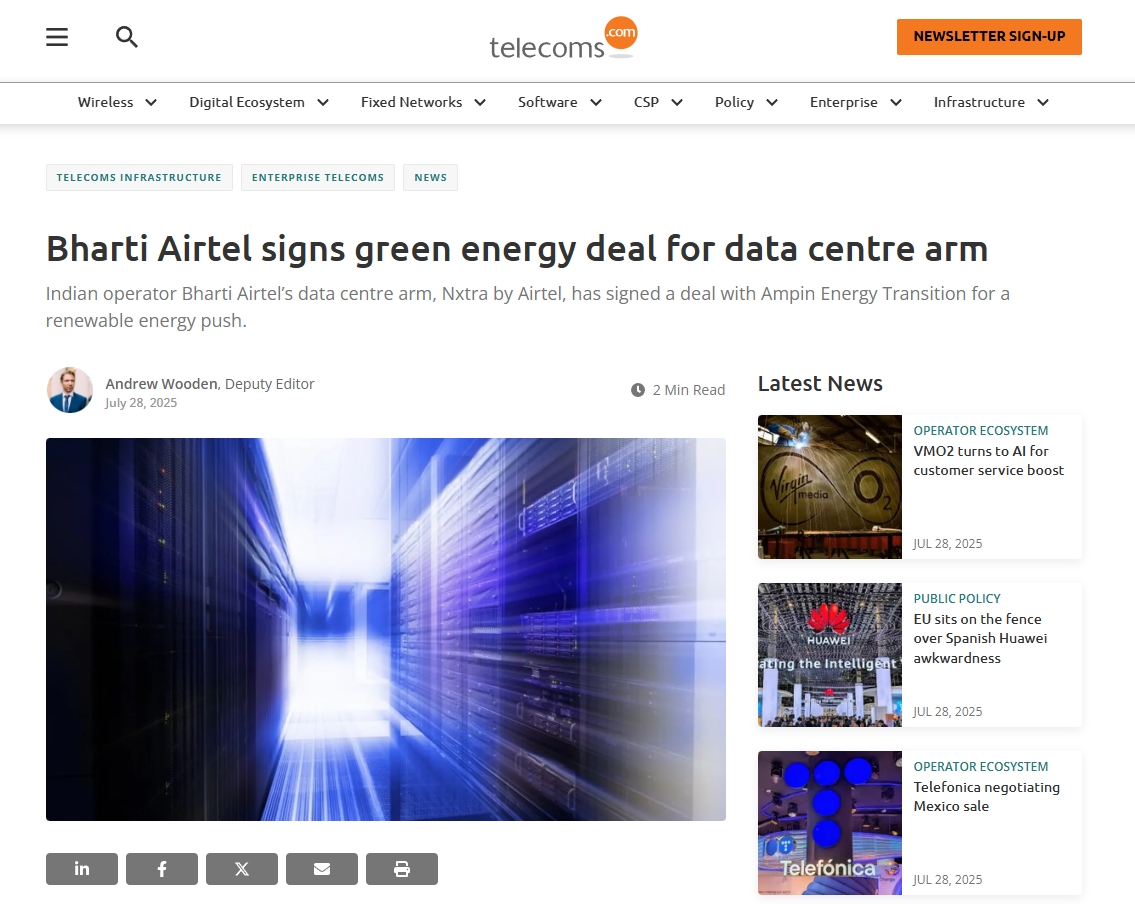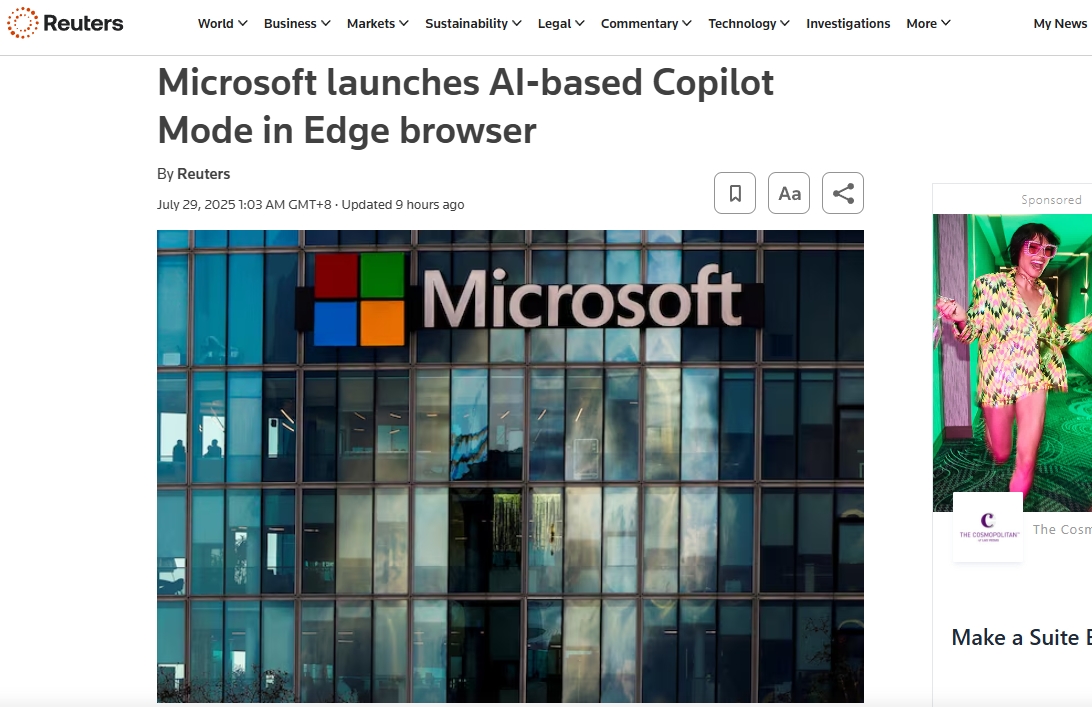From Proof-of-Work to Proof-of-Compute
In the early 2020s, Bitcoin miners were celebrated—and often criticized—for their sheer energy consumption. Massive facilities in rural America, Iceland, and Kazakhstan ran day and night, performing trillions of hash calculations per second to secure the Bitcoin network. But as the economics of crypto mining evolved, and AI infrastructure demand exploded, many of these miners found themselves facing a strategic crossroads.
By mid-2025, a surprising transformation is well underway: dozens of former Bitcoin mining firms have begun to repurpose their infrastructure into AI data centers, turning their GPU-rich, power-intensive setups into rentable compute farms for training, inference, and high-performance computing.
The pivot is not just opportunistic—it’s strategic. Mining companies are realizing that their expertise in power procurement, thermal management, and bare-metal server operation uniquely positions them to succeed in the growing AI infrastructure economy.
Why Crypto Mining Firms Are Well-Positioned to Serve AI
At first glance, Bitcoin mining and AI might seem like unrelated worlds. But a closer look reveals that many of the requirements overlap:
Massive electrical capacity: Mining farms are often located in regions with direct substation access and can handle 10MW+ loads.
Efficient cooling systems: Miners already operate hot machines in dense clusters, sometimes in challenging climates.
Low-latency fiber: Most have optimized network setups for rapid transaction verification and uptime reliability.
Automation and monitoring expertise: These firms built some of the first fully automated, remote-managed compute centers.
While the underlying workloads are different—hashing SHA-256 vs. training transformer models—the operational DNA is largely the same.
Market Dynamics Driving the Shift
There are several macroeconomic forces accelerating the mining-to-AI pivot:
1. Declining Bitcoin Block Rewards
With the 2024 halving, the BTC reward for mining a block dropped from 6.25 to 3.125 coins. As profitability tightens, many miners are reconsidering long-term viability.
2. Energy Regulations and Local Pressure
States like New York and provinces like British Columbia have passed moratoriums or restrictions on crypto mining. AI, on the other hand, is seen as a public-benefit workload with enterprise and academic use cases.
3. Surging Demand for AI Compute
Training a large language model today can cost millions of dollars in GPU time. Inference, too, requires constant, reliable access to high-performance clusters. Traditional cloud providers can’t meet the demand fast enough.
4. Investor Pressure
Publicly traded miners like Riot, Marathon Digital, and Hut 8 are under pressure to diversify revenue streams, especially as institutional interest in crypto has plateaued.
For these companies, pivoting to AI is a way to both future-proof and capitalize on the most important computing trend since the cloud revolution.
High-Profile Examples of the Transition
Core Scientific
Once one of the largest crypto mining companies in the U.S., Core Scientific filed for bankruptcy in 2022. Today, it has restructured and emerged as a bare-metal AI infrastructure provider, offering H100 cluster rentals to AI startups and research labs.
Bitfarms
Based in Canada, Bitfarms has converted one of its Quebec facilities into an AI training center, installing AMD MI300X racks to support open-source model development in partnership with university labs.
Hive Digital Technologies
Hive, one of the earliest GPU miners, now runs a mixed-use facility that serves crypto, AI, and rendering workloads. Its customers include AI inference platforms, generative art applications, and biotech startups.
Marathon Digital
While still focused on Bitcoin, Marathon is investing in a joint venture with a hyperscale cloud provider to retrofit some of its Texas facilities for AI compute leasing.
These companies are not abandoning Bitcoin entirely—but they’re hedging aggressively with AI infrastructure.
Technical Adjustments: What It Takes to Pivot
The shift from mining to AI isn’t plug-and-play. It requires:
Hardware Upgrades: ASICs used for Bitcoin mining are not useful for AI. Miners must acquire or lease GPUs like the H100, A100, or MI300X.
Networking Overhauls: AI workloads need high-speed interconnects (e.g., InfiniBand or 100G Ethernet) for model training across distributed nodes.
Storage Infrastructure: AI training needs fast, scalable storage—NVMe clusters, object storage, and high-throughput pipelines.
Software Stack: Most miners are unfamiliar with PyTorch, TensorFlow, Kubernetes, or Slurm. Building or hiring teams to manage these is essential.
Power Reprofiling: AI clusters often spike differently than ASICs. Load balancing, UPS systems, and thermal mapping must be reevaluated.
Those that succeed can transform their sites into AI-first data centers that serve a broader market with higher margins.
Business Models Emerging from the Transition
Companies that pivot are offering services such as:
GPU rental and leasing: Clients pay for compute time on-demand or in blocks.
Model hosting: Specialized support for LLMs, diffusion models, and multimodal workloads.
Inference-as-a-Service: Turnkey platforms for startups without infrastructure teams.
Training support: Cluster access with built-in model orchestration and storage support.
AI render farms: Useful for animation, gaming, and video generation pipelines.
Several firms are also exploring carbon-offset AI workloads, repurposing waste heat, and integrating with district heating grids—moves that improve both economics and ESG ratings.
Risks and Challenges
Despite the opportunity, the pivot is not without risk:
Capital Requirements: GPUs are expensive, and retrofitting facilities costs millions.
Talent Gaps: Infrastructure teams trained on ASICs and crypto stacks must upskill rapidly or be replaced.
Customer Acquisition: Competing with established players like Lambda Labs or Crusoe Energy requires aggressive marketing and pricing strategies.
Unpredictable Workload Behavior: AI workloads are bursty and harder to schedule than Bitcoin mining, which runs 24/7 at full throttle.
Miners must also manage the reputational baggage of the crypto sector. Many enterprise customers view crypto with skepticism and will need assurances about reliability, security, and compliance.
Policy and Market Implications
This shift could change how policymakers view former mining regions. Instead of energy-intensive operations that offer few long-term jobs, these retrofitted facilities may become:
AI infrastructure hubs
Regional training centers
High-tech job creators
Governments in Texas, Georgia, and even Wyoming are beginning to craft incentive packages to encourage transitionsfrom mining to AI, offering tax credits and permitting support for facilities that pivot.
Meanwhile, private equity and venture funds are starting to acquire distressed mining assets, betting they can redeploy them as AI-first properties with better returns and more stable clients.
The Broader Trend: Compute Realignment
The story of Bitcoin miners turning into AI infrastructure providers is part of a larger realignment:
Crypto mining helped develop rural power corridors and build out grid infrastructure.
Now, that same capacity is being reabsorbed into the broader digital economy.
AI is no longer something that lives solely in Seattle, Ashburn, or Silicon Valley—it’s spreading across the Midwest, the South, and global edge regions.
This transition mirrors how the early internet piggybacked on telecom infrastructure built for voice. We’re seeing a similar repurposing—and it may turn out to be one of the more productive outcomes of the crypto era.








